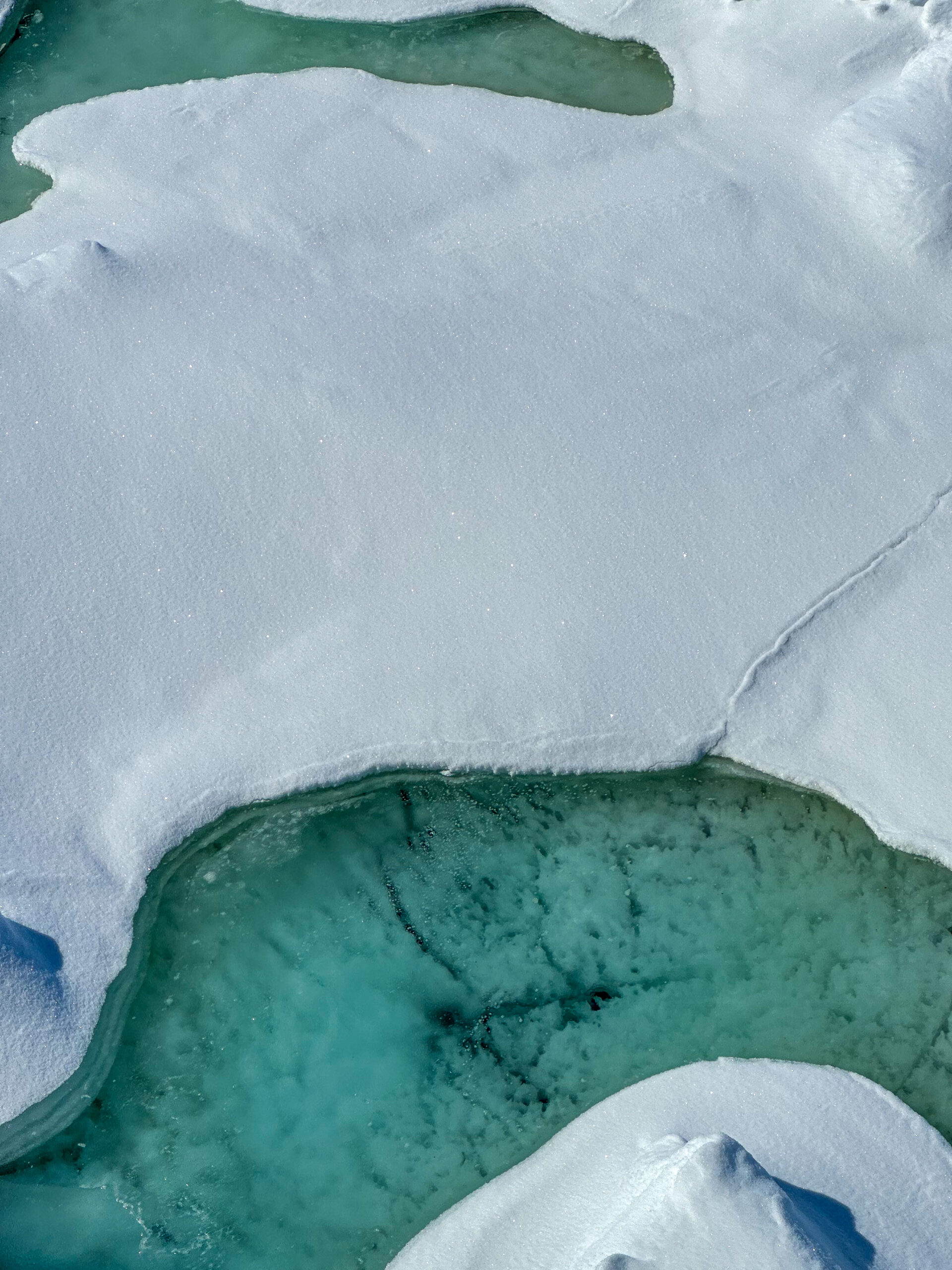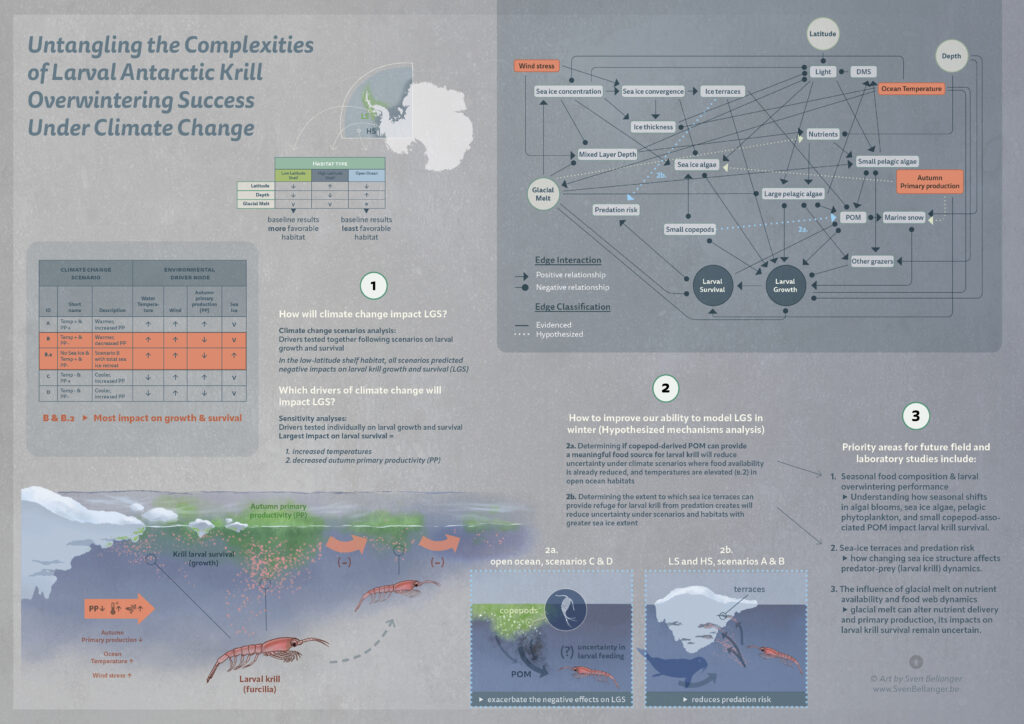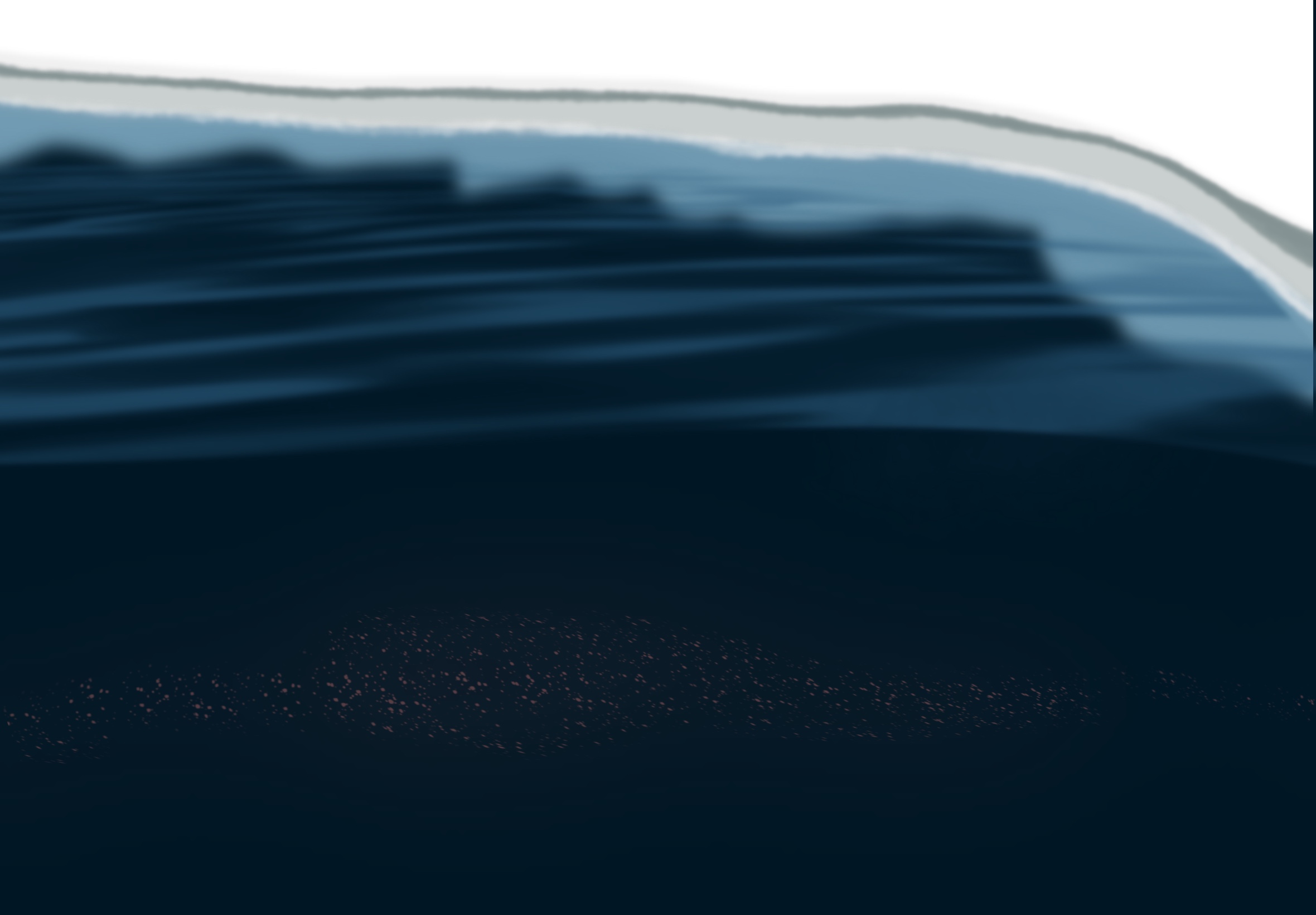
Shifting Swarms
Understanding Uncertainty and Vulnerability
Krill in the face of a changing climate
As the climate changes, understanding how krill respond to warming temperatures, changing sea ice conditions, and ocean acidification is critical to predicting broader impacts on the Antarctic food web.
This page is dedicated towards elevating the ongoing research that can help us build a more complete understanding of krill vulnerability and adaptability in a rapidly changing Southern Ocean.
Research Highlights
Stay up to date with the latest findings from SKEG members investigating krill responses to climate change, or just go watch some krill on the Krill Cam! Or go and check out our list of the most recent krill publications.
Featured Research: Climate change and larval krill overwintering
Untangling the complexities of larval Antarctic krill overwintering success under climate change
April 2025
Zephyr T Sylvester, Devi Veytia, Alexis A Bahl, Dominik Bahlburg, Deborah Benkort, Sophie Bestley, Bulut Cagdas, Alison C Cleary, Andrew Constable, Stuart Corney, Bettina A Fach, Nicole Hellessey, Simeon L Hill, Nadine M Johnston, Sara Labrousse, Benjamin Merkel, Eugene J Murphy, Roshni C Subramaniam, Sally Thorpe, Ben Raymond, Untangling the complexities of larval Antarctic krill overwintering success under climate change, ICES Journal of Marine Science, Volume 82, Issue 4, April 2025, fsaf049, https://doi.org/10.1093/icesjms/fsaf049

Antarctic krill depend on sea ice during early life stages, yet climate-driven sea ice loss threatens their overwinter survival. Sylvester et al. 2025 uses a qualitative network model (QNM) to investigate how interacting processes — from autumn productivity to sea-ice refuge — may shape larval survival under future climate scenarios in the southwest Atlantic. The model suggests major declines in recruitment on the North Antarctic Peninsula shelf, while some open-ocean habitats may see improved survival in cooler conditions that support sea-ice-associated food and shelter. By incorporating both evidence-based and hypothesized mechanisms, such as sea-ice terraces as predator refuges, the study highlights critical uncertainties and points to key areas for future research.
Get in touch or check back later to see if we featured your research!
Research Topics
Climate Change Impacts on Krill Populations – Synthesis
As sea ice declines and ocean temperatures rise, krill may face habitat compression, altered food availability, and disrupted life cycles. These changes not only threaten krill survival and reproduction but also ripple through the food web, affecting predators like penguins, seals, and whales. These papers synthesize current knowledge of krill responses to environmental change, often highlighting physiological thresholds, ecosystem roles, and future research directions.
Kawaguchi et al. (2024) – Climate change impacts on Antarctic krill behaviour and population dynamics
This review highlights how climate-driven reductions in sea ice and warming temperatures are reshaping krill habitats, leading to a poleward contraction of populations in the Southwest Atlantic. These shifts may intensify overlap between fisheries and predators, increasing risks to penguins and recovering whale populations. The authors call for urgent mitigation and a circumpolar monitoring network using emerging technologies.
DOI: 10.1038/s43017-023-00504-y
McBride et al. (2021) – Antarctic krill: spatial distribution, abundance, and management of fisheries in a changing climate
This review synthesizes recent findings on how climate change affects krill distribution and abundance, and examines the implications for fisheries management. The authors highlight inconsistencies in observed trends, the potential for vertical foraging shifts, and the need for adaptive management by CCAMLR to respond to climate-driven changes in krill and predator populations.
DOI: 10.3354/meps13705
Siegel et al. (2015) – Biology and Ecology of Antarctic krill
This book offers a comprehensive overview of the state of knowledge on Antarctic krill biology, including climate change impacts on krill physiology, population dynamics and spatial distribution.
DOI: 10.1007/978-3-319-29279-3
Flores et al. (2012) – Impact of climate change on Antarctic krill
This review outlines how warming, ocean acidification, and sea-ice loss could reduce krill reproductive success and recruitment, with cascading effects on the food web DOI: 10.3354/meps09831
Field-Based Studies
Observational research from SKEG members documents real-time changes in krill distribution, body condition, reproduction, and recruitment across different regions of the Southern Ocean.
Ichii et al. (2023) – Impact of the climate regime shift around 2000 on recruitment of Antarctic krill at the Antarctic Peninsula and South Georgia
This study shows that climate regime shifts have weakened the connectivity of krill populations at the Antarctic Peninsula and South Georgia. However, krill stocks remained stable in both regions, suggesting that alternative pathways may have been established with other krill populations in areas such as the Scotia Sea.
DOI: 10.1016/j.pocean.2023.103020
Atkinson et al. (2019) – Krill distribution contracts southward during rapid regional warming
Observations show a poleward contraction of krill distribution, suggesting that warming is pushing populations into more limited southern habitats
DOI: 10.1038/s41558-018-0370-z
Trathan et al. (2012) – Ecological drivers of change at South Georgia: the krill surplus, or climate variability
This study documents dramatic declines in macaroni penguin populations at South Georgia, linking the changes to competition with recovering fur seal populations and potential reductions in krill abundance. The authors suggest that tropho-dynamic interactions and historical human impacts may explain the observed shifts, with climate variability playing a compounding role.
DOI: 10.1111/j.1600-0587.2012.07330
Additional highlights coming soon – please contact us to suggest relevant publications.
The Carbon Cycle
The huge abundance of krill in the Southern Ocean is crucial for the functioning of the biological carbon pump in this region. During this process, organisms export significant quantities of carbon from the surface waters to the deep sea in the form of their carcasses, faecal matter, moulted skin, and other organic matter.
Smith et al. (2025) – Antarctic krill vertical migrations modulate seasonal carbon export
This study used a year-long seafloor lander deployment in Prydz Bay, East Antarctica, to directly observe krill diel vertical migration (DVM) and its role in the biological carbon pump. The data revealed that only a quarter of the krill population engaged in vertical migrations, with strong seasonal variability. Contrary to previous assumptions, migrating krill contributed less than 10% of the total krill-driven particulate organic carbon (POC) export. Most carbon export occurred via fecal pellets from non-migrating krill. These findings challenge the long-held view that vertical migration is a major pathway for carbon sequestration in the Southern Ocean and highlight the need to refine carbon flux models to account for seasonal and behavioral variability in krill.
DOI: 10.1126/science.adq5564
Manno et al. (2020) – Continuous moulting by Antarctic krill drives major pulses of carbon export in the north Scotia Sea, Southern Ocean
This study uses sediment traps to demonstrate that krill exuviae, which sink after moulting, play a significant role in the transfer of particulate organic carbon to the deep sea, on a comparable scale to faecal pellets. As moulting frequency tends to increase with temperature and food availability, exuviae make a particularly significant contribution to krill-specific carbon flux in summer.
Cavan et al. (2019) – The importance of Antarctic krill in biogeochemical cycles
This synthesis highlights the underappreciated role of Antarctic krill in nutrient cycling and carbon sequestration. With their massive biomass and daily vertical migrations, krill actively transport and transform nutrients, stimulate phytoplankton productivity, and contribute to the oceanic carbon sink. The study emphasizes that both adult and larval krill play critical roles in these processes. However, the biogeochemical consequences of krill fishing remain poorly understood. The authors argue that fishery management must account for krill’s ecosystem engineering functions, not just their role as prey.
DOI: 10.1038/s41467-019-12668-7
Additional highlights coming soon – please contact us to suggest relevant publications.
Experimental Studies
Experimental studies enable researchers to keep krill in controlled conditions and assess their response to environmental variation at high detail.
Michael et al. (2021) – Facing Southern Ocean warming: Temperature effects on whole animal performance of Antarctic krill (Euphausia superba)
In this study, the authors kept krill in water at different temperatures for 8 months, tracking their growth and physiology. No differences in growth were observed in krill kept in water below 3.5°C, but growth declined significantly at higher temperatures, which are typically found within the northern limits of the krill’s distribution range.
DOI: 10.1016/j.zool.2021.125910
Saba et al. (2021) – Combined effects of ocean acidification and elevated temperature on feeding, growth, and physiological processes of Antarctic krill Euphausia superba
The authors found that adult krill showed short-term responses to changes in pH levels (e.g. reduced feeding rates at increased acidity), but these differences disappeared after a 21-day acclimatisation period. Of the two stressors, temperature had a stronger impact on krill physiology throughout the experiment than pH levels did.
DOI: 10.3354/meps13715
Ericson et al. (2018) – Adult Antarctic krill proves resilient in a simulated high CO2 ocean
To assess the impact of ocean acidification on krill growth and development, the authors of this study kept adult krill kept under various seawater pH-levels. It was found that adult krill could maintain many important physiological functions (growth, lipid storage, sexual maturity) across the range of tested pH-levels.
DOI: 10.1038/s42003-018-0195-3
Modeling and Projection Studies
From individual-based models to large-scale ecosystem simulations, the following studies explore potential future outcomes for krill under various climate scenarios. They often integrate physical oceanography, sea ice dynamics, and biological processes.
Green et al. (2024) – KRILLPODYM: a mechanistic, spatially resolved model of Antarctic krill distribution and abundance
This novel model integrates krill life history, habitat suitability, and ocean circulation to simulate spatial dynamics of krill populations. It captures how environmental drivers like sea ice and primary production influence krill biomass and demographics. KRILLPODYM provides a powerful tool for forecasting krill responses to climate change and informing sustainable fishery management.
DOI: 10.3389/fmars.2023.1218003
Bahlburg et al. (2023) – An intercomparison of models predicting growth of Antarctic krill (Euphausia superba): The importance of recognizing model specificity
This study compared existing krill growth models to analyze the sensitivity of krill growth predictions to the chosen model. The authors found significant differences between the models and emphasized the importance of ensuring the compatibility of analysis scales (local, regional or circumpolar), input data properties (in situ, remote sensing or model-based) and the chosen model to improve prediction robustness.
Swadling et al. (2023) – Biological responses to change in Antarctic sea ice habitats
Modeling shows that krill populations are likely to decline in response to warming and reduced sea-ice duration, particularly in the Ross Sea and western Antarctic Peninsula
DOI: 10.3389/fevo.2022.1073823
Veytia et al. (2020) – Circumpolar projections of Antarctic krill growth potential
This study presents a circumpolar assessment of projected changes in krill growth potential, combining an empirical growth model with the weighted output of several Earth system models. The authors found that while many krill habitats were expected to experience moderate changes in growth potential, those at the northern end of the krill’s distribution range were expected to see substantial declines.
DOI: 10.1038/s41558-020-0758-4
Klein et al. (2018) – Impacts of rising sea temperature on krill increase risks for predators in the Scotia Sea
Using a minimally realistic ecosystem model, this study projects that ocean warming will reduce krill biomass, especially in the northern Scotia Sea, with cascading effects on predators like penguins, whales, and seals. The authors find that reducing krill fishing can mitigate some of the risks associated with climate change, and emphasize the importance of spatially structured management to protect vulnerable predator populations.
DOI: 10.1371/0191011
Piñones & Fedorov (2016) – Projected changes of Antarctic krill habitat by the end of the 21st century
Climate models project a significant reduction in suitable krill habitat due to warming and sea-ice decline, especially in the northern parts of their current range
DOI: 10.1002/2016GL069656
Kawaguchi et al. (2013) – Risk maps for Antarctic krill under projected Southern Ocean acidification
In this study, the authors conducted lab experiments of hatching success in krill embryos under varying pCO2-concentrations, and used these findings to project the hatching success of embryos under expected changes in pCO2-concentrations at circumpolar scales in 2100 and 2300. Important krill habitats such as the Weddell Sea or the Haakon VII Sea were identified as particularly vulnerable.
DOI: 10.1038/nclimate1937
📣 Want to Feature Your Research?
Are you working on krill and climate change? We’re always looking to showcase new research from the SKEG community. If you’ve published a recent paper, have work in press, or want to highlight an ongoing project, we’d love to include it.
👉 Submit your research using the form below

Got a question?
Reach out with any and all questions, comments or suggestions!
